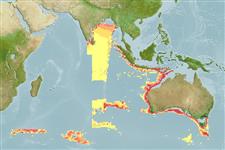Lớp phụ Cá sụn (cá mập và cá đuối) (sharks and rays) >
Squaliformes (Sleeper and dogfish sharks) >
Squalidae (Dogfish sharks)
Etymology: Squalus: Genus name from Latin 'squalus' meaning shark (Ref. 6885, 27436); nasutus: Name from Latin 'nasutus' meaning large-nosed, referring to its elongated prenarial snout..
More on authors: Last, Marshall & White.
Environment: milieu / climate zone / depth range / distribution range
Sinh thái học
Biển; Mức độ sâu 300 - 850 m (Ref. 58443), usually 300 - 400 m (Ref. 58443). Tropical
Eastern Indian Ocean: Western Australia. Probably extending to Westerm Pacific, the Philippines and Indonesia.
Length at first maturity / Bộ gần gũi / Khối lượng (Trọng lượng) / Age
Maturity: Lm ?, range 46 - ? cm
Max length : 49.9 cm TL con đực/không giới tính; (Ref. 58443); 59.0 cm TL (female)
Short description
Hình thái học | Sinh trắc học
This small species of the ‘japonicus group’ has the following set of characters: very elongate body, depth 9.4-11.4% TL; narrow and long snout, preoral length 1.85-2.01 times its horizontal prenarial length, 11.1-11.7% TL; large eyes, 4.3-5.1% TL; secondary lobe of anterior nasal flap is well developed; small, raked dorsal fins; first dorsal-fin spine short, weak; second dorsal-fin spine short with strong base; pectoral fin of adult not falcate; pectoral-fin inner margin is short, 6.6-7.1% TL; caudal bar almost upright, short, broad, extending from the caudal fork to the posterior margin of the upper lobe for 0.4-0.5 of its length, upper caudal blotch is somewhat linear, and is located near the dorsal margin of fin lobe; flank denticles weakly tricuspidate; monospondylous centra 36-39, precaudal centra 78-81, total centra 103-109 (Ref. 58443).
Occurs on or near the bottom of the upper continental slope at 298-850 m; viviparous with yolk-sac dependency; no reproductive and diet data are available, however, it is presumed that the species feeds on small fishes, cephalopods, and crustaceans (Ref. 58048). Trawled mainly in 300-400 m (Ref. 58443). Marketed for its meat, fins, and liver oil which is of high value (Ref. 58048).
Life cycle and mating behavior
Chín muồi sinh dục | Sự tái sinh sản | Đẻ trứng | Các trứng | Sự sinh sản | Ấu trùng
Distinct pairing with embrace (Ref. 205).
Last, P.R., L.J. Marshall and W.T. White, 2007. Squalus nasutus sp. Nov., a new long-snout spurdog of the 'japonicus-group' from the Inidan Ocean. pp. 83-90. In P.R. Last, W.T. White and J.J. Pogonoski Descriptions of new dogfishes of the genus Squalus (Squaloidea:Squalidae). CSIRO Marine and Atmospheric Research Paper No. 014. 130 pp. (Ref. 58443)
IUCN Red List Status (Ref. 130435)
Threat to humans
Harmless
Human uses
Thêm thông tin
Age/SizeSự sinh trưởngLength-weightLength-lengthLength-frequenciesSinh trắc họcHình thái họcẤu trùngSự biến động ấu trùngBổ xungSự phong phúBRUVS
Các tài liệu tham khảoNuôi trồng thủy sảnTổng quan nuôi trồng thủy sảnCác giốngDi truyềnElectrophoresesDi sảnCác bệnhChế biếnNutrientsMass conversion
Các công cụ
Special reports
Download XML
Các nguồn internet
Estimates based on models
Preferred temperature (Ref.
123201): 8.9 - 13.1, mean 10.8 °C (based on 56 cells).
Phylogenetic diversity index (Ref.
82804): PD
50 = 0.5000 [Uniqueness, from 0.5 = low to 2.0 = high].
Bayesian length-weight: a=0.00339 (0.00162 - 0.00707), b=3.10 (2.93 - 3.27), in cm total length, based on LWR estimates for this Genus-body shape (Ref.
93245).
Mức dinh dưỡng (Ref.
69278): 4.2 ±0.3 se; based on size and trophs of closest relatives
Thích nghi nhanh (Ref.
120179): thấp, thời gian nhân đôi của chủng quần tối thiểu là 4.5 - 14 năm (Preliminary K or Fecundity.).
Fishing Vulnerability (Ref.
59153): Moderate vulnerability (44 of 100).
